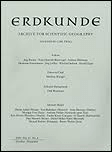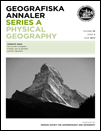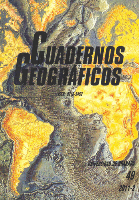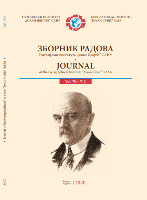
Miscellanea Geographica
Scope & Guideline
Navigating the Landscape of Scholarly Discovery
Introduction
Aims and Scopes
- Interdisciplinary Geography:
The journal integrates various sub-disciplines of geography, including human geography, physical geography, environmental science, and urban studies, fostering a holistic understanding of geographical phenomena. - Regional Studies:
A significant focus on regional studies, particularly in Central and Eastern Europe, examining local development, environmental changes, and socio-economic factors affecting specific regions. - Methodological Innovations:
Utilization of advanced methodologies such as remote sensing, machine learning, and text mining to enhance geographical research and provide new insights into spatial dynamics. - Cultural and Historical Geography:
Exploration of cultural and historical dimensions of geography, including the impact of historical events on current geographical landscapes and the role of cultural memory in urban environments. - Environmental and Climate Research:
Research on environmental changes, climate variability, and their implications for natural and human systems, focusing on both local and global scales.
Trending and Emerging
- Urban Resilience and Memory:
Emerging studies on urban environments are increasingly focusing on the concept of resilience, particularly how cultural memory and local identity shape urban experiences and responses to environmental changes. - Climate Change Adaptation Strategies:
There is a growing emphasis on research that explores adaptation strategies to climate change, particularly in relation to local governance and community resilience. - Geospatial Technologies and Big Data:
An increase in the use of geospatial technologies and big data analytics, including machine learning and remote sensing, is evident, reflecting a trend towards data-driven geographical research. - Sustainable Development in Tourism:
Research on sustainable tourism development is gaining traction, with a focus on balancing economic growth with environmental conservation and community engagement. - Cultural Geography and Identity Politics:
An emerging focus on cultural geography, particularly how identity politics influence geographical spaces and local development, is becoming more prominent in recent publications.
Declining or Waning
- Traditional Land Use Studies:
There has been a noticeable decrease in studies focused solely on traditional land use practices, possibly due to a shift towards more integrated approaches that combine socio-economic and environmental factors. - Historical Geography without Contemporary Relevance:
Research that examines historical geographical aspects without connecting them to contemporary issues appears to be waning, as the journal increasingly emphasizes relevance to current challenges. - Purely Theoretical Frameworks:
The journal has moved away from papers that rely heavily on theoretical frameworks without empirical data, favoring studies that offer practical insights and applications.
Similar Journals

Erdkunde
Connecting Earth Sciences with Ecological PerspectivesErdkunde is a pivotal academic journal published by the Geographisches Institut, University of Bonn, dedicated to the fields of Geography, Earth and Planetary Sciences, and Ecology. With a history dating back to 1976, this journal serves as a platform for interdisciplinary research and discourse, reflecting diverse perspectives from both theoretical and applied dimensions within these domains. Published in Germany, it currently holds a respectable position within the academic community, classified in Q2 for Geography, Planning and Development and Q3 in Ecology and Earth and Planetary Sciences. Although not an open-access journal, its contribution is significant, offering insights that advance our understanding of spatial dynamics and environmental processes. With Scopus rankings that place it within the median range, Erdkunde is an essential resource for researchers, professionals, and students looking to deepen their knowledge and engage with contemporary trends in geographic research.

GEOGRAFISKA ANNALER SERIES A-PHYSICAL GEOGRAPHY
Charting New Paths in Earth and Planetary SciencesGeografiska Annaler Series A-Physical Geography, published by Taylor & Francis Ltd, is a leading academic journal dedicated to the advancing field of physical geography. With a rich publication history spanning from 1979 to 2024, this journal stands out in its categories, being positioned in the Q2 quartile for both Geography, Planning and Development and Geology in 2023. The journal is recognized for its contribution to Earth and Planetary Sciences, evidenced by its Scopus rankings placing it in the top 31% and 32% of its respective disciplines. Belonging to a distinguished publisher from the United Kingdom, it provides a vital platform for researchers, professionals, and students to disseminate and engage with cutting-edge research. While the journal does not currently offer open access, it remains a pivotal resource for those involved in the study of physical geography, offering insights that enhance our understanding of the Earth's processes and environments.

Cuadernos Geograficos
Unlocking insights into our dynamic earth-surface processes.Cuadernos Geograficos is a distinguished open access journal published by UNIV GRANADA in Spain, dedicated to advancing the fields of geography, planning, and earth-surface processes. With an ISSN of 0210-5462 and E-ISSN 2340-0129, this journal has been serving as an essential platform for scholars since its inception in 1983. By providing rigorous peer-reviewed research, Cuadernos Geograficos contributes significantly to the academic discourse within these disciplines, holding a respectable position in the Q3 category for both Earth-Surface Processes and Geography, Planning, and Development as of 2023. The journal is indexed in Scopus, ranking #431/821 in Social Sciences and #100/179 in Earth and Planetary Sciences, affirming its relevance and impact within the scholarly community. With its commitment to open access since 1999, Cuadernos Geograficos ensures that vital research is accessible to a diverse audience of researchers, professionals, and students, fostering knowledge sharing and collaborative advancements in the geographical sciences.

Revista Geoaraguaia
Advancing Knowledge in Human and Social SciencesRevista Geoaraguaia, published by UNIV FEDERAL MATO GROSSO, is an esteemed open-access journal dedicated to advancing research in the field of human and social sciences. Based in Brazil, this journal facilitates scholarly communication and fosters interdisciplinary approaches, exploring topics that encompass geography, sociology, and environmental studies. Although specific metrics like H-Index and impact factor are not listed, the journal is committed to providing a platform for innovative research that addresses pressing societal challenges. Researchers, academics, and students will find a rich repository of articles that not only contribute to theoretical frameworks but also enhance practical applications in various settings. By connecting local and global issues, Revista Geoaraguaia plays a crucial role in promoting academic discourse and advancing knowledge in the vibrant landscape of Latin American studies.

Journal of the Geographical Institute Jovan Cvijic SASA
Unlocking insights into our planet's processes and people.The Journal of the Geographical Institute Jovan Cvijic SASA is a premier academic publication dedicated to advancing research and knowledge in diverse fields such as Demography, Earth-Surface Processes, Geography, Geology, and Tourism. Published by the Geographical Institute Jovan Cvijic SASA in Serbia, this Open Access journal has made significant contributions to the academic community since its inception in 1951, allowing for unrestricted dissemination of research findings globally. With an impact factor reflected in its 2023 Q3 quartile rankings across several categories, the journal underlines its relevance by maintaining a significant standing in the Social Sciences and Earth and Planetary Sciences domains, demonstrating engagement at a global level evidenced by its Scopus rankings. The journal's commitment to publishing high-quality, peer-reviewed articles makes it an essential resource for researchers, professionals, and students seeking to explore and enhance their understanding of geographical and environmental dynamics.

GEOGRAFICKY CASOPIS-Geographical Journal
Exploring the dynamic relationship between earth and society.GEOGRAFICKY CASOPIS-Geographical Journal is a prestigious publication dedicated to advancing knowledge in the fields of geography and earth sciences, published by the SLOVAK ACADEMY OF SCIENCES, INSTITUTE OF GEOGRAPHY. With a rich history dating back to its inception in 1976, the journal serves as a vital forum for researchers and professionals to disseminate their findings across a range of topics including earth-surface processes, geography, planning, development, and geology. Notably, it maintains a respectable Q3 category ranking across these disciplines as of 2023, indicating its contribution to relevant academic discourse. The journal is indexed under critical databases and engages a global audience, making it an essential resource for scholars seeking to stay informed about contemporary issues and advancements in geography. Although currently not an open-access journal, it emphasizes the sharing of significant research findings and encourages submissions from various geographical contexts to enrich the scientific community. Geographical Journal's commitment to fostering interdisciplinary dialogue ensures its relevance and importance in shaping the future of geographical research.

Moravian Geographical Reports
Connecting Geographical Insights with Global ImpactWelcome to the Moravian Geographical Reports, an esteemed Open Access journal published by SCIENDO, dedicated to advancing the fields of Earth and Planetary Sciences as well as Geography, Planning and Development. Established in 1993, this journal has steadily built a reputation for disseminating high-quality research, evidenced by its 2023 Q2 ranking in both relevant categories and an impressive Scopus percentile ranking of 72. With a dedicated editorial board and an expanding global readership, the Moravian Geographical Reports serves as a vital platform for researchers, professionals, and students alike, fostering dialogue and collaboration across various dimensions of geographical and environmental studies. Since its shift to Open Access in 2013, it has significantly enhanced the accessibility and reach of its published works, making crucial research findings available to a broader audience. The journal continues to thrive as a significant contributor to the geographical and earth sciences discourse during its converged years from 1993 to 2024.

Geoadria
Fostering Dialogue in Environmental ResearchGeoadria, an esteemed Open Access journal published by the University of Zadar in Croatia, has been at the forefront of disseminating valuable research since its inception in 1996. With a keen focus on atmospheric science, demography, earth-surface processes, and geography, this journal serves as a crucial platform for researchers and professionals aiming to explore the intricate relationships between these fields. Although it currently holds a Q4 quartile ranking in various categories, such as Atmospheric Science and Geography, its commitment to promoting innovative scholarly dialogue ensures its relevance and utility within the academic community. Geoadria is indexed in Scopus, with rankings that reflect its ongoing contribution to the social sciences and earth sciences, notably garnering attention in niche areas. With a dedication to open access since 1996, the journal stands as a testament to the University of Zadar's commitment to enhancing global knowledge. Researchers, professionals, and students interested in geography, demography, and environmental sciences will find Geoadria a vital resource for the latest empirical studies and theoretical discussions.

Quaestiones Geographicae
Connecting Researchers to the Heart of GeographyQuaestiones Geographicae, an esteemed open-access journal published by SCIENDO, serves as a vital platform for scholarly communication in the field of Earth and Planetary Sciences. Since its inception in 1979, the journal has been dedicated to promoting rigorous research and discourse in geography, encompassing a breadth of topics that reflect the dynamic nature of the discipline. With an impressive Impact Factor belonging to the Q3 quartile category, the journal actively contributes to the global scientific community's understanding of geographical phenomena. Its commitment to open-access publishing since 2010 ensures that groundbreaking research is accessible to a wider audience, facilitating collaboration and innovation. As part of its enduring legacy, Quaestiones Geographicae engages researchers, professionals, and students alike, inviting them to explore, share, and expand the boundaries of geographical knowledge.

Geographica Pannonica
Exploring the Dimensions of Geography and BeyondGeographica Pannonica is a premier, open-access journal dedicated to the various dimensions of geography, atmospheric sciences, geology, and related fields. Published by the University of Novi Sad's Faculty of Natural Sciences and Mathematics, this Serbian journal has been a vital platform for scholarly discourse since its inception, with an open-access policy established in 2010 to enhance the dissemination of research findings. Covering a spectrum of topics from Earth-surface processes to tourism management, the journal has achieved notable rankings, reflecting its commitment to impactful research—ranking in the Q3 quartile across multiple categories in 2023. Researchers, professionals, and students are encouraged to engage with the latest articles that contribute to advancing our understanding of geographical phenomena and sustainability challenges, making Geographica Pannonica an essential resource for the global academic community.